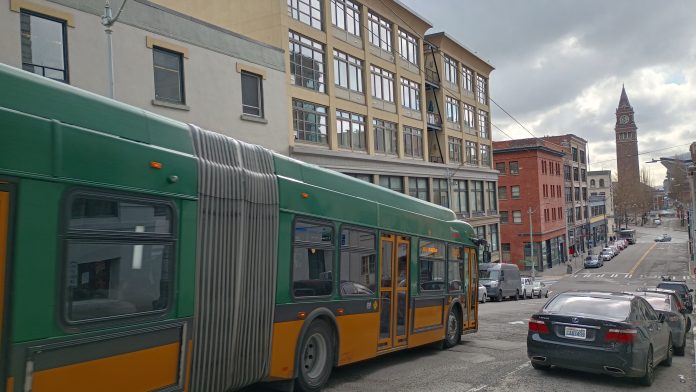
One of Seattle’s most heavily used bus stops is heading toward a badly needed upgrade soon thanks to coordination between King County Metro and the Seattle Department of Transportation (SDOT). The southbound stop on 3rd Avenue S between S Washington Street and S Main Street, which currently features an incredibly narrow sidewalk next to a puddle-magnet of a parking strip, will see a complete overhaul by next year if all goes according to plan.
The project, funded primarily with dollars from the Federal Transit Administration (FTA), is just the latest in a series of upgrades aimed at improving things for riders along Puget Sound’s busiest bus corridor.
This southbound stop is one of the busiest in Pioneer Square, with riders boarding routes 7, 14, 21, 36, 124, 131, and 132, and riders getting off a broad array of buses after coming through the entire Third Avenue corridor. This is the first stop south of Yesler Way, where the northbound and southbound bus corridors downtown diverge. With this project, 3rd Avenue S will go from being a two-way street between Washington and Main Streets to fully one-way, with a new extended sidewalk taking over the curbside lane where buses currently stop along the west side of the street.
Upgraded bus shelters, lighting, and real-time information signs will go in, along with new street trees. The asphalt bus lane, which is in incredibly bad shape, will be replaced with concrete, extending the life of the street — and conceivably the busses using it and today bouncing along its deep ruts and craters.
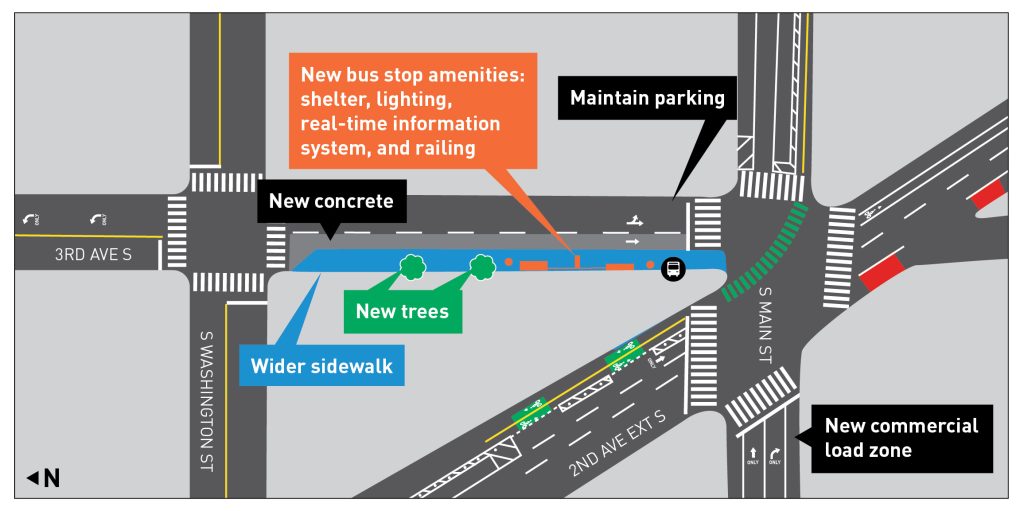
This work comes as the future of Third Avenue comes under increasing scrutiny as various factions center the transit street in their vision for downtown Seattle’s future. One of Mayor Bruce Harrell’s first actions after taking office was to close some of Third Avenue’s bus stops in the name of crime prevention, consolidating riders at other locations.
Harrell’s State of the City address this week included a focus on improving downtown, with the Mayor detailing a recent in-person visit to Third Avenue to see how things are going.
“In the coming months you’ll hear more about what we’re referring to as our Downtown Activation Plan: DAP…these will reflect both immediate activation strategies to make downtown safer and more welcoming, along with long-term transformational enhancements designed for residents, and workers, and neighborhoods, and neighbors, and tourists,” Harrell said.
Last year, the City Council officially endorsed an effort to take another comprehensive look at Third Avenue by way of the Downtown Seattle Association’s (DSA) work to re-envision the future of the street as Sound Transit’s light rail expansion leads to somewhat fewer buses on the corridor. There are a lot of potential avenues that work can end up taking, but many Seattle residents view the corridor’s status as a transit street directly contributing to the problem.
In an op-ed for Post Alley last week, former city councilmember Jean Godden, who served between 2003 and 2015, suggests that the future of the street is not as a transit street.
“We should try putting cars back on Third, beautifying the area with street trees and putting some bus routes on adjacent streets,” Godden wrote. “The calamity that Third has become separates the city from the charms of the Pike Place Market and the Waterfront. Time to take our streets back.”
It is not exactly clear how the corridor will be improved by moving some bus routes onto adjacent streets, slowing all traffic with more private vehicles, yet not providing the human services or street improvements that could provide relief and better circulation.
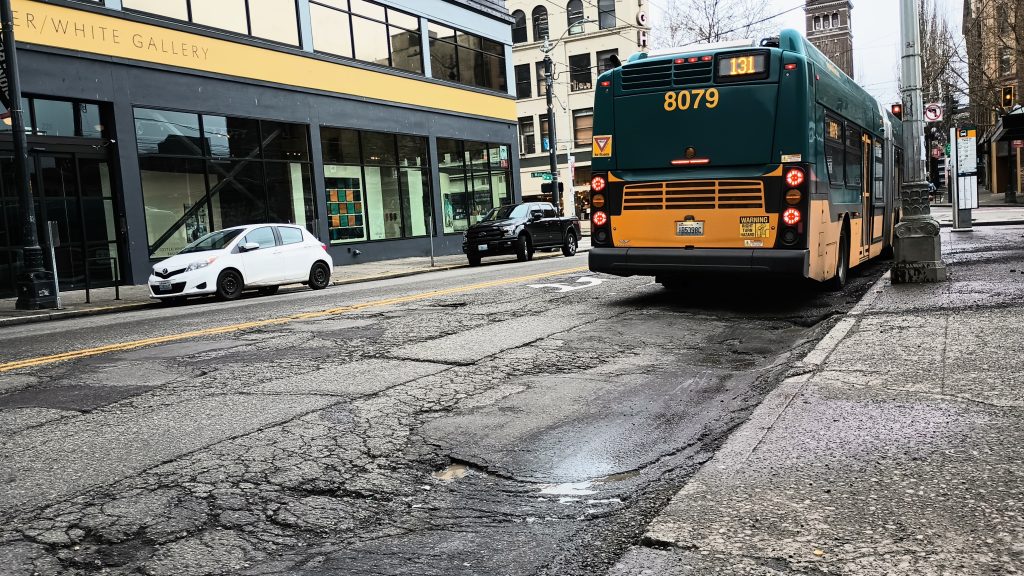
But Godden’s view is fairly widely held: buses and crime go hand-in-hand. It is also a view that omits how much work on Third Avenue remains undone. As opposed to blaming buses for Third’s issues and giving up, the City could complete the plans to improve the street experience.
Even as the city looks toward Third Avenue’s next phase, upgrades at this south end of Third Avenue are essentially the last piece in a nearly decade-long plan to improve the corridor to improve bus operations and add rider amenities. Many of these improvements are easy to miss, like expanded sidewalks or new shelters. Others have been more noticeable, like the long-awaited queue jump for northbound buses at Denny Way. In 2014 and 2015, Metro and the City of Seattle collaborated on a corridor-wide plan that in retrospect looks incredibly similar to the DSA’s Third Avenue Vision.
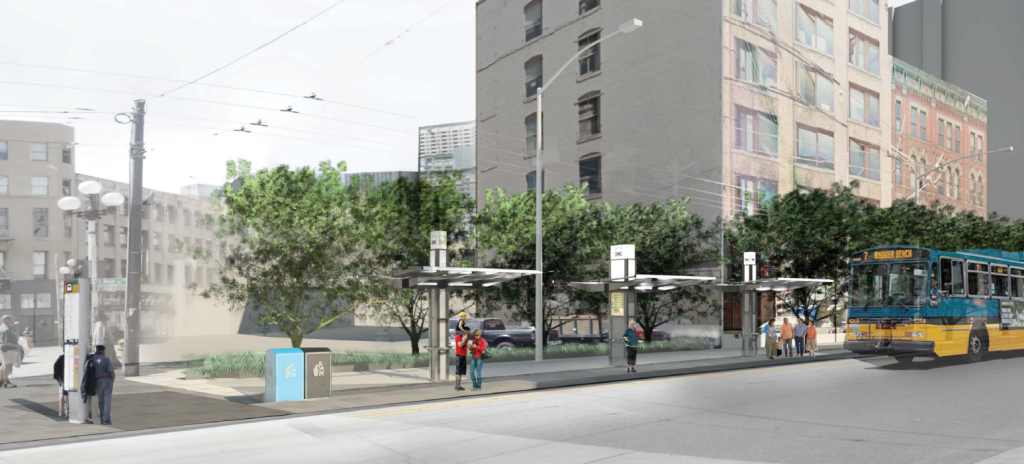
That final concept included a lot of ideas that never saw the light of day, like constructing raised crosswalks for nearly every cross street along the corridor that communicate that intersections remain the domain of transit riders and pedestrians. But concepts like the Denny Way queue jump, which finally opened in 2021, were only able to gain traction thanks to the development of that full report. With the expanded sidewalk and improved stop at Third and Main, that work is essentially done.
Also included in that work were potential attempts to activate the public spaces along the corridor, something that does not directly help transit riders but which everyone agrees is badly needed on Third Avenue to make the street more inviting to everyone. Near Third and Yesler, underused street space was envisioned as being converted into seating and greenery. But it’s hard to see anything like that gaining traction now, where hostile infrastructure that does its best to repel misuse is a go-to. City Hall Park, in the shadow of the King County Courthouse, sits behind fencing since 2021 with no imminent plans for reopening. And that’s the paradox for Third Avenue right now: the City both does and does not actually want activation.
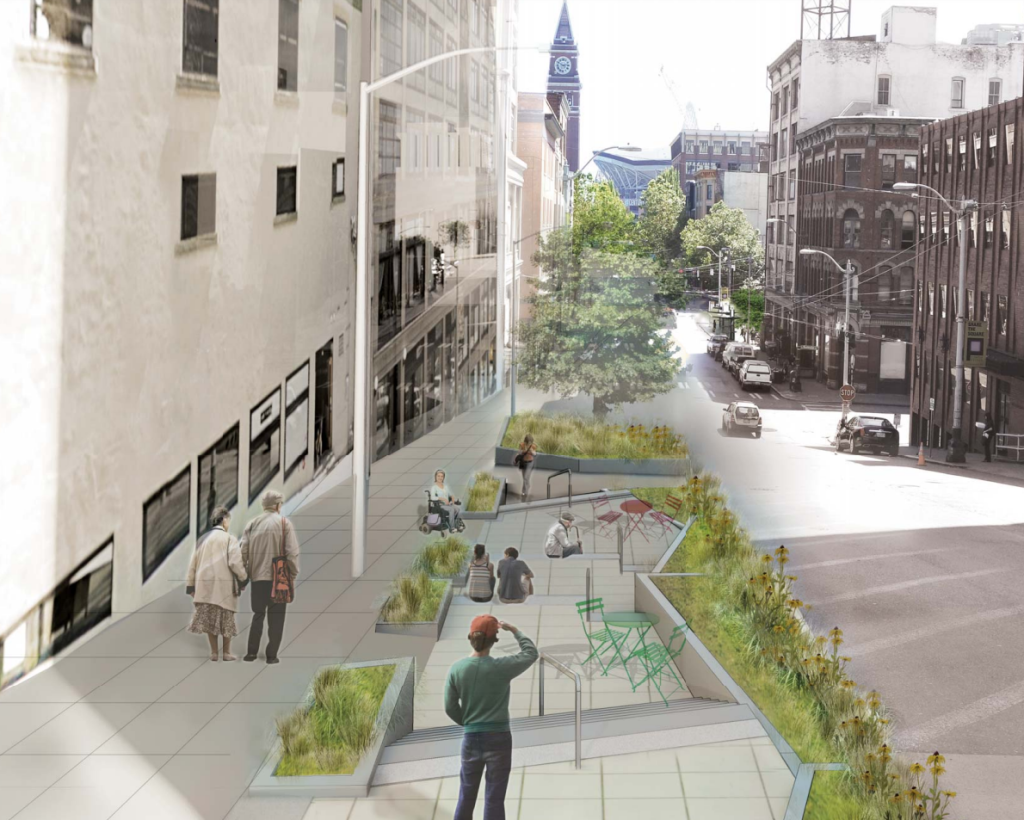
Thanks to Metro, SDOT, and the FTA, Third Avenue is still being improved for bus riders even as many would prefer to give up on the corridor. The longer-term solutions that will truly develop the street into the welcoming downtown doorstep won’t be easy to implement, but if done right, could help achieve so many of the city’s goals. Giving up on Third Avenue isn’t an option.
Ryan Packer has been writing for The Urbanist since 2015, and currently reports full-time as Contributing Editor. Their beats are transportation, land use, public space, traffic safety, and obscure community meetings. Packer has also reported for other regional outlets including BikePortland, Seattle Met, and PubliCola. They live in the Capitol Hill neighborhood of Seattle.

